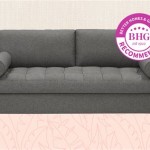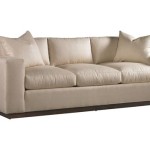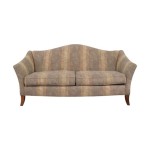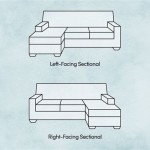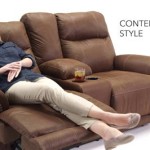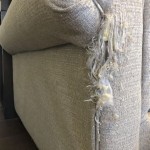What is the Standard Depth of Sofa Cushions in Inches?
The depth of sofa cushions is a crucial element influencing the overall comfort and aesthetic appeal of a sofa. It dictates how far back a person can sit and how well they are supported. Understanding the standard depths can aid in choosing the most appropriate sofa for individual needs and spatial constraints. This article will explore the standard sofa cushion depths available, factors affecting the ideal cushion depth, and how cushion depth relates to the overall sofa dimensions.
Sofa cushion depth is generally measured from the front edge of the seat cushion to the back of the seat cushion where it meets the backrest. It's important to distinguish this from the overall depth of the sofa, which includes the frame, the backrest, and any decorative elements that extend beyond the seating area. Primarily, cushion depth contributes significantly to the user's experience. Too shallow, and a person may feel perched and unsupported. Too deep, and shorter individuals could find it difficult to sit comfortably with their feet on the floor.
Typical Range of Sofa Cushion Depths
The "standard" depth of sofa cushions can fall within a fairly broad range, influenced by style, design, and intended use. Generally, sofa cushion depths range from 20 inches to 40 inches. However, it's important to be aware that this is a generalized range, and variations exist depending on the specific sofa design.
Sofas designed for formal living rooms or spaces where upright posture is preferred might feature cushions with depths ranging from 20 to 24 inches. These shallower cushions encourage a more formal seating position, promoting conversation and preventing excessive lounging. They are often paired with firmer cushion fills to maintain structure and support.
Mid-range sofas, intended for general use, often have cushion depths between 25 and 30 inches. This range offers a good balance between support and relaxation, making it suitable for a variety of activities, from watching television to reading. This is a very common depth for standard sofas found in many households.
For sofas designed with lounging and relaxation in mind, such as those found in media rooms or casual living spaces, cushion depths can extend from 31 to 40 inches. These deeper cushions allow for more relaxed postures, including sprawling and reclining. They are frequently paired with softer cushion fills to enhance the feeling of comfort and envelopment. This category often includes sectional sofas and those marketed as "cloud" sofas due to their plush, sink-in feel.
Beyond these general categories, some specialty sofas may feature cushion depths outside of this range. Loveseats, designed for smaller spaces or for two people, might have shallower cushions. Conversely, oversized sectional sofas or custom-designed pieces can have significantly deeper cushions to accommodate specific design requirements.
Factors Influencing Ideal Sofa Cushion Depth
Several factors contribute to determining the ideal sofa cushion depth for a given space and user. Considering these factors helps ensure that the chosen sofa is both comfortable and functional.
Firstly, the intended use of the sofa plays a significant role. A sofa primarily intended for formal entertaining will benefit from shallower cushions to promote upright seating, while a sofa designed for movie nights will be more comfortable with deeper cushions that allow for lounging. Determining the primary activities the sofa will support is a crucial initial step.
Secondly, the height of the users should be considered. Shorter individuals may find it difficult to sit comfortably on sofas with very deep cushions, as their feet may not reach the floor. Conversely, taller individuals may feel cramped on sofas with shallow cushions. Ideally, a user should be able to sit with their back supported and their feet flat on the floor or comfortably resting on a footrest. Opting for sofas with adjustable lumbar support or incorporating throw pillows can help customize the seating experience for different heights.
Thirdly, the overall room size and layout must be taken into account. A sofa with very deep cushions can overwhelm a small space, making it feel cramped. Conversely, a sofa with shallow cushions can appear undersized in a large room. Measuring the available space and considering the sofa's proportions relative to other furniture is essential for creating a balanced and harmonious design. Using painter's tape to outline the sofa's footprint on the floor can be a helpful visualization tool.
Fourthly, the style of the sofa and the overall aesthetic of the room will influence the appropriate cushion depth. Modern, minimalist sofas often feature shallower cushions and clean lines, while traditional or transitional sofas may have deeper cushions and more ornate details. Choosing a sofa that complements the existing décor and architectural style is crucial for achieving a cohesive look.
Finally, personal preference plays a significant role. Some individuals prefer the feeling of being enveloped by deep cushions, while others prefer the firmer support of shallower cushions. Visiting furniture stores and testing out different sofa styles is the best way to determine personal preferences and find the most comfortable option. Paying attention to the cushion fill material, such as foam, down, or a combination, also impacts overall comfort.
Relationship Between Cushion Depth and Overall Sofa Dimensions
While cushion depth is a critical dimension, it's essential to understand how it relates to the overall dimensions of the sofa. This understanding helps ensure the sofa fits the space and provides the desired level of comfort.
The overall depth of a sofa encompasses not only the cushion depth but also the thickness of the backrest, the frame, and any decorative elements that extend beyond the seating area. A sofa with a shallow cushion depth might still have a considerable overall depth if it features a thick, angled backrest. Conversely, a sofa with a deep cushion depth might have a relatively compact overall depth if it has a minimalist frame and a low-profile backrest.
The overall width of the sofa is another important dimension to consider in conjunction with cushion depth. A wide sofa with shallow cushions can feel disproportionate, while a narrow sofa with deep cushions can feel cramped. Ensuring that the width and depth are balanced contributes to a visually appealing and comfortable seating experience.
The seat height, measured from the floor to the top of the seat cushion, also influences the perceived comfort of the cushion depth. A sofa with a low seat height and deep cushions can be very comfortable for lounging, while a sofa with a high seat height and deep cushions might be difficult to get in and out of, especially for shorter individuals. The combination of seat height and cushion depth should be carefully considered to ensure accessibility and comfort for all users.
The backrest height also plays a significant role. A lower backrest, often paired with deeper cushions, encourages a more relaxed, reclined posture. Higher backrests, often paired with shallower cushions, promote a more upright and formal seating position. The backrest height should complement the cushion depth to provide adequate support and comfort.
When selecting a sofa, it's crucial to consider all of these dimensions in relation to one another and to the overall room size. Sketching a floor plan and using furniture templates can help visualize how different sofa sizes and configurations will fit within the space. It's also helpful to consider the placement of other furniture, such as coffee tables and side tables, to ensure that there is enough space for comfortable movement and interaction.
In summary, understanding the relationship between cushion depth and other sofa dimensions is crucial for choosing a sofa that is both comfortable and aesthetically pleasing. By carefully considering these factors, individuals can select a sofa that perfectly suits their needs and enhances their living space.
Beyond the standard measurements, custom sofa options provide for tailored cushion depths. Working with a furniture designer or manufacturer allows for specifying exact dimensions to meet specific requirements. This approach is particularly useful for accommodating unique body types, addressing specific comfort needs, or matching existing furniture pieces. Customization can also incorporate adjustable features, such as removable lumbar supports or adjustable headrests, to further enhance comfort and personalization.
Ultimately, selecting the right sofa cushion depth involves a careful consideration of several factors, including intended use, user height, room size, style preferences, and overall sofa dimensions. By paying attention to these details, individuals can choose a sofa that provides optimal comfort, support, and aesthetic appeal, creating a welcoming and functional living space.

Sofa Dimensions For 2 3 4 5 6 Person Couches Diagrams Included Home Stratosphere

Sofa Dimensions A Comprehensive Guide To Diffe Couch Sizes

Sofa Dimensions For 2 3 4 5 6 Person Couches Diagrams Included Home Stratosphere

The Perfect Sofa Backrest Height Explained By Experts Cozylant

Finding The Perfect Cushion Size Covers Pads Furn Com

Sofa Secrets How To Choose The Right Seat Depth And Cushions

Sofa Dimensions For 2 3 4 5 6 Person Couches Diagrams Included Home Stratosphere

Sofa Seat Cushions Pick The Perfect Depth Stated Home Blog

Guide To Choose Comfortable Deep Seat Sofas For Your Space Povison Blogs

Sofa Dimensions A Ultimate Guide Homenish

